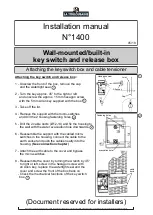
2. PCI Interface
41
PowerSpan II User Manual
80A1010_MA001_09
Integrated Device Technology
www.idt.com
Mapping to the Processor Interface
The PCI Target Image controls the transaction type on the processor bus through the use of the PB
Read Transfer Type (RTT[4:0]) and PB Write Transfer Type (WTT[4:0]) bits in the
Image x Control Register” on page 268
. By default, these bit fields assign reads as read operations on
the processor bus, and assign incoming writes as Write with Flush on the Processor Bus.
Mapping to a PCI Interface
The PCI Target Image determines the address space on the destination PCI bus through the use of the
Image Mode (MODE) bit in the
“PCI-1 Target Image x Control Register” on page 268
. By default,
incoming PCI transactions are mapped to Memory Space on the alternate PCI Interface. Setting the
MODE bit maps incoming PCI transactions to
I/O Space on the alternate PCI Interface.
2.2.1.4
Address Parity
The PCI target image monitors parity during the address phase of decoded transactions. Address parity
errors are reported on Px_SERR# when both the Parity Error Response (PERESP) and SERR Enable
(SERR_EN) bits are set in the
“PCI-1 Control and Status Register.” on page 251
. Assertion of the
Px_SERR# signal can be disabled by clearing the SERR_EN bit.
PowerSpan II records an error condition in the event of an address parity error (see
). PowerSpan II claims the errored transaction and forwards the transaction to the
destination bus.
2.2.2
Data Phase
The data phase deals with control of burst length and byte lane management.
2.2.2.1
Writes
PowerSpan II accepts single beat or burst transactions in memory space. I/O accesses are not decoded.
All writes to the PCI Target are posted writes.
Burst writes are linear bursts. A Target-Disconnect is issued if a buffer fills while a burst write is in
progress (see
“Termination Phase” on page 44
). PowerSpan II can manage arbitrary PCI byte enable
combinations during PCI burst writes.
2.2.2.2
Reads
PowerSpan II supports up to four concurrent reads from external PCI masters. All four reads are treated
equally and have the same prefetch capacity, but have individually programmable values.
PowerSpan II does not support delayed write transactions as described in the
PCI 2.2
Specification
.
















































